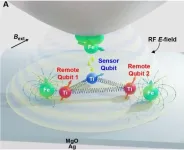(Press-News.org) A fundamental discovery about the Fischer Tropsch process, a catalytic reaction used in industry to convert coal, natural gas or biomass to liquid fuels, could someday allow for more efficient fuel production.
Washington State University researchers discovered previously unknown self-sustained oscillations in the Fischer Tropsch process. They found that unlike many catalytic reactions which have one steady state, this reaction periodically moves back and forth from a high to a low activity state. The discovery, reported in Science, means that these well-controlled oscillatory states might be used in the future to enhance the reaction rate and the yields of desired products.
“Usually, rate oscillations with large variations in temperature are unwanted in chemical industry because of safety concerns,” said corresponding author Norbert Kruse, Voiland Distinguished Professor in WSU’s Gene and Linda Voiland School of Chemical Engineering and Bioengineering. “In the present case, oscillations are under control and mechanistically well understood. With such a basis of understanding, both experimentally and theoretically, the approach in research and development can be completely different – you really have a knowledge-based approach, and this will help us enormously.”
Although the Fischer Tropsch process is commonly used for fuel and chemical production, researchers have had little understanding of how the complex catalytic conversion process works. The process uses a catalyst to convert two simple molecules, hydrogen and carbon monoxide, into long chains of molecules – the hydrocarbons that are used widely in daily life.
While a trial-and-error approach has been used in research and development in the fuels and chemical industries for more than a century, researchers will now be able to design catalysts more intentionally and tune the reaction to provoke oscillatory states that could improve the catalytic performance.
The researchers first came upon the oscillations by accident after graduate student Rui Zhang approached Kruse with a problem: he wasn’t able to stabilize the temperature in his reaction. As they studied it together, they discovered the surprising oscillations.
“That was pretty funny,” Kruse said. “He showed it to me, and I said, ‘Rui, congratulations, you have oscillations! And then we developed this story more and more.”
The researchers not only discovered that the reaction develops oscillatory reaction states, but why it does so. That is, as the temperature of the reaction goes up due to its heat production, the reactant gases lose contact with the catalyst surface and their reaction slows down, which reduces the temperature. Once the temperature is sufficiently low, the concentration of the reactant gases on the catalyst surface increases and the reaction picks up speed again. Consequently, the temperature increases to close the cycle.
For the study, the researchers demonstrated the reaction in a lab employing a frequently used cobalt catalyst, conditioned by adding cerium oxide, and then modeled how it worked. Co-author Pierre Gaspard at the Université Libre de Bruxelles developed a reaction scheme and theoretically imposed periodically changing temperatures to replicate the experimental rates and selectivities of the reaction.
“It’s so beautiful that we were able to model that theoretically,” said corresponding author Yong Wang, Regents Professor in WSU’s Voiland School who also co-advised Zhang. “The theoretical and the experimental data nearly coincided.”
Kruse has been working on oscillatory reactions for more than 30 years. The discovery of the oscillatory behavior with the Fischer Tropsch reaction was very surprising because the reaction is mechanistically extremely complicated.
“We have a lot of frustration sometimes in our research because things are not going the way you think they should, but then there are moments that you cannot describe,’’ Kruse said. “It's so rewarding, but ‘rewarding’ is a weak expression for the excitement of having had this fantastic breakthrough.”
The work was supported by the Chambroad Chemical Industry Research Institute Co., Ltd., the National Science Foundation and the Department of Energy’s Basic Energy Sciences Catalysis Science program.
END
Discovery made about Fischer Tropsch process could help improve fuel production
2023-10-05
ELSE PRESS RELEASES FROM THIS DATE:
New discovery may ‘unlock’ the future of infectious disease and cancer treatment
2023-10-05
University of Birmingham News Release
STRICTLY EMBARGOED UNTIL 14.00 Thursday 5th October ET 2023/ 19.00 Thursday 5th October UK 2023
Researchers have identified a ‘guard mechanism’ for a protein which attacks microbes in infected cells, opening the possibility of new treatments for Toxoplasma, Chlamydia, Tuberculosis and even cancer.
A study, led by the University of Birmingham and published today (5th October) in Science has discovered the lock and key mechanism that controls the attack protein GPB1. GBP1 is activated during ...
Study shows prior exposure to common virus shields against birth defects and miscarriage
2023-10-05
Researchers at Tulane University have shown for the first time that mothers are much less likely to transmit a common virus known to cause miscarriages and birth defects if they are exposed to the virus prior to becoming pregnant. The study marks a significant step toward the development of a vaccine that could protect mothers and their babies.
Cytomegalovirus (CMV) is a common herpesvirus that most women contract unknowingly before reaching child-bearing age. It's usually harmless except during pregnancy when, if passed on to the developing fetus, it is a leading cause ...
A new qubit platform is created atom by atom
2023-10-05
Seoul, Korea - Researchers at the IBS Center for Quantum Nanoscience (QNS) at Ewha Womans University have accomplished a groundbreaking step forward in quantum information science. In partnership with teams from Japan, Spain, and the US, they created a novel electron-spin qubit platform, assembled atom-by-atom on a surface. This breakthrough was published in the journal Science on 2023/10/06.
Unlike previous atomic quantum devices on surfaces where only a single qubit could be controlled, the researchers at QNS successfully demonstrated the ability to control multiple qubits simultaneously, enabling the application of single-, two-, and three-qubit gates.
Qubits, ...
Brain is ‘rewired’ during pregnancy to prepare for motherhood
2023-10-05
Francis Crick Institute press release
Under strict embargo: 19:00hrs BST Thursday 5 October 2023
Peer reviewed
Experimental study
Animals
Researchers at the Francis Crick Institute have shown that pregnancy hormones ‘rewire’ the brain to prepare mice for motherhood.
Their findings, published today in Science, show that both oestrogen and progesterone act on a small population of neurons in the brain to switch on parental behaviour even before offspring arrive. These adaptations resulted in stronger and more selective responses to pups.
It is well known that while virgin female rodents do not show much interaction with pups, ...
Vulnerability to different COVID-19 mutations depends on previous infections and vaccination, study suggests
2023-10-05
A person’s immune response to variants of SARS-CoV-2, the virus that causes COVID-19, depends on their previous exposure – and differences in the focus of immune responses will help scientists understand how to optimise vaccines in the future to provide broad protection.
A new study has found that people differ in how vulnerable they are to different mutations in emerging variants of SARS-CoV-2.
This is because the variant of SARS-CoV-2 a person was first exposed to determines how well their immune system responds to different parts of the virus, and how protected they are against other variants.
It also means that the same COVID-19 ...
The end of genes: routine test reveals unique divergence in genetic code
2023-10-05
Scientists testing a new method of sequencing single cells have unexpectedly changed our understanding of the rules of genetics.
The genome of a protist has revealed a seemingly unique divergence in the DNA code signalling the end of a gene, suggesting the need for further research to better understand this group of diverse organisms.
Dr Jamie McGowan, a postdoctoral scientist at the Earlham Institute, analysed the genome sequence of a microscopic organism - a protist – isolated from a freshwater pond at Oxford University Parks.
The work was intended to test a DNA ...
Conscience launches to tackle drug discovery and development for diseases sidelined by pharmaceutical science
2023-10-05
TORONTO (5 October 2023) – Conscience, a game-changing non-profit venture focused on enabling drug discoveries for diseases that have received limited attention from the pharmaceutical industry, launched today with pioneering support from the Canadian government.
With CA$105.7 million in funding, including $49 million from the Canadian government and the engagement of industry, academia, government and patient advocacy groups, Conscience seeks to lead global drug discovery and development for emerging, rare or complex ...
Isis presents a special bibliographic issue on the history of pandemics
2023-10-05
In 1913, historian of science George Sarton created what has become the Isis Current Bibliography of the History of Science (IsisCB). For the last 110 years, the journal Isis has included a comprehensive survey of the recent work in the history of science and allied fields, first in each issue and later as a full yearly supplement. Now the basis of a free online search tool called IsisCB Explore, the IsisCB continues to serve as an indispensable reference for scholars and students.
“Bibliographic ...
Plot thickens in hunt for ninth planet
2023-10-05
CLEVELAND—A pair of theoretical physicists are reporting that the same observations inspiring the hunt for a ninth planet might instead be evidence within the solar system of a modified law of gravity originally developed to understand the rotation of galaxies.
Researchers Harsh Mathur, a professor of physics at Case Western Reserve University, and Katherine Brown, an associate professor of physics at Hamilton College, made the assertion after studying the effect the Milky Way galaxy would have on objects in the outer solar system—if the laws of gravity were governed by a theory known as Modified ...
Factors associated with marijuana use among high-risk college students
2023-10-05
The past decade has seen a significant increase in marijuana use among U.S. college students. This increase has coincided with notable changes in national and local cannabis laws and policies, and perceptions of the associated drug’s risk over the same period. However, cannabis use by students continues to be a public health challenge throughout the country. Universities have long relied on education programs to address these risks; however, many of these programs have limitations and fail to consider some of the modern risk factors ...


